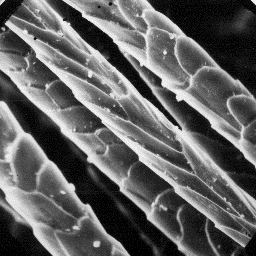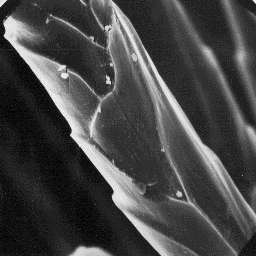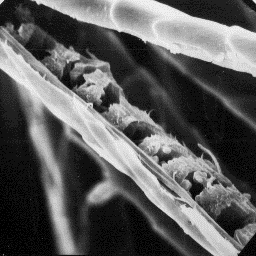 Chinchilla laniger
Chinchilla laniger
------------------
English: Chinchilla
German: Chinchilla
French: Chinchilla
Spanish: Chinchilla
Distribution areas
------------------
The short-tailed chinchilla and others
species of chinchilla live in South America.
The animal inhabits mountainous regions,
mainly in Chile. It has become very rare in
its natural habitat and is now raised on
chinchilla farms.
The surface structure
Description of the fur of the skin, 200x
----------------------
The skin is from 30 to 40 cm long. The fur is of the softest kind and along
the back, it measures 20 to 30 mm or even more in thickness. The colour of the
under-fur fibres is dark-grey while the upper part of the coat is much
lighter, almost white. On the belly, the colour is yellowish. The under-fur
layer is about 15 mm thick; the length of the longest guard hairs is about
35 mm. The guard hairs are straight but, in the under-fur layer, the fibres
are finely waved or curled. All the hairs are very fine; the guard hairs
cannot be distinguished easily with the naked eye.
|
|
 Chinchilla laniger
Chinchilla laniger
------------------
English: Chinchilla
German: Chinchilla
French: Chinchilla
Spanish: Chinchilla
These guard hairs are about three times
the thickness of the fine fibres.
Structure of the hair
---------------------
The microscopic skin surface structure
appears furrowed. The hair follicles are
wide with straight edges. The average
follicle contains numerous clusters of the A group of the fine hairs,
fibres. Often these clusters are found 1000x
ingroups of two or three side by side.
The fine fur fibres are circular, and in the upper part of the hair shaft
also ellipsoidal, in cross-section. The diameter is in the range of 7 to
18 µm. The cuticular scales are cornet-like with a finely grooved scale
surface and smooth scale margins. These fibres have a wide, unbroken, central
symmetrical-shaped medulla belonging to the fractured uniserial ladder type
with a granular infilling material.
|
|
 Chinchilla laniger
Chinchilla laniger
------------------
English: Chinchilla
German: Chinchilla
French: Chinchilla
Spanish: Chinchilla
The intermediate fibres have a circular,
and in the upper part of the shaft
ellipsoidal, cross-section with a diameter
of about 20 to 26 µm. The cuticle is cornet-
like at the lowest part, and rounded tile-
like in the middle and upper parts, of the
shaft. The scale surface is finely grooved
and the scale margins are smooth. The
medulla is wide, unbroken and of the central The cuticular structure
symmetrical type. The overall structure of of the fine fibres, 2000x
the medulla belongs to the loose uniserial
ladder type with a granular infilling material.
The guard hairs are from 26 to 38 µm in diameter. These fibres are
ellipsoidal in cross-section in the lower part of the shafts but, at the tip,
they are flattened into spear-shaped ends often with a dumb-bell-shaped cross-
section. The cuticular scales are of the rounded tile-like type with a dumb-
bell-shaped cross-section.
|
|
 Chinchilla laniger
Chinchilla laniger
------------------
English: Chinchilla
German: Chinchilla
French: Chinchilla
Spanish: Chinchilla
The cuticular scales are of the rounded
tile-like type with a smooth surface in the
lower part of the shaft and a grooved
surface in the flattened tips. The scale
margins are straight. The medulla is wide,
unbroken and central symmetrical-shaped,
belonging to the loose uniserial ladder type
with a granular infilling material.
Longitudinal section
of a fine fur fibre, 2000x
|
|
 Chinchilla laniger
Chinchilla laniger
------------------
English: Chinchilla
German: Chinchilla
French: Chinchilla
Spanish: Chinchilla
The cuticular structure
of the fine fibres, 2000x
Numerical code for chinchilla skin structure
--------------------------------------------
Surface of the skin: 3-2-3
Fine fur fibres: 1.2-3.5-2-1-2-1-1-2-6-20.26-15.30
Intermediate fibres: 1.2-3.5-2-1-2-1-1-2-6-20.26-15.30
Guard hairs: 2.8-3-1.2-1-2-1-1-2-6-26.38-20.35
|




